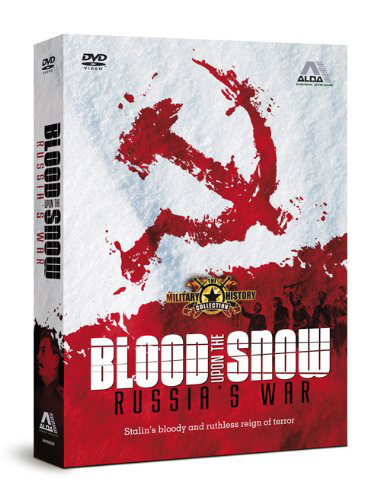Blood upon the Snow: Russia’s War
2010. DVD. Alba Home Video. 520 minutes. £29.99
About the author: Dr Nick Baron is Associate Professor, Faculty of Arts University of Nottingham and author of The King of Karelia: Col. P.J. Woods and the British Intervention in North Russia, 1918-1919 (2007, Francis Boutle).
E-mail: nick.baron@nottingham.ac.uk
… the first major television production to direct the western public’s attention to the heroism and, particularly, to the horrors of the Eastern Front
The collapse of the USSR in 1991 brought about unprecedented access to the formerly secret Soviet state and party archives, as well as unimagined opportunities for collaboration between Russian and western historians and filmmakers. The British-Russian documentary television series Blood upon the Snow: Russia’s War (1995) was one of the earliest and most important products of this new openness. In ten fifty-two-minute episodes, it traces the rise of Stalin and the Soviet experience of the Second World War. As such, it was the first major television production to direct the western public’s attention to the heroism and, particularly, to the horrors of the Eastern Front, and the first to bring to light archival footage and interviews with eyewitnesses of events. By contrast, the landmark series The World at War (1973-74) devoted no more than three of its twenty-six hour-long episodes to the Eastern Front.
 Former US Secretary of State Henry Kissinger opens each episode with a brief scene-setting monologue and ends each with a few words anticipating the next instalment. While Kissinger’s interventions add little to the historical analysis, his presence serves to emphasise the world-changing significance of the subject matter to a western audience. British actor Nigel Hawthorne provides the main voice-over for the series. His grave lilting tone is well chosen to convey the tense and frequently harrowing drama of the story as it unfolds.
Former US Secretary of State Henry Kissinger opens each episode with a brief scene-setting monologue and ends each with a few words anticipating the next instalment. While Kissinger’s interventions add little to the historical analysis, his presence serves to emphasise the world-changing significance of the subject matter to a western audience. British actor Nigel Hawthorne provides the main voice-over for the series. His grave lilting tone is well chosen to convey the tense and frequently harrowing drama of the story as it unfolds.
The first two episodes, ‘The Darkness Descends’ and ‘The Hour Before Midnight’, chart Stalin’s rise to power, his policies of mass mobilisation and repression in the1930s and the immediate international and domestic background to the outbreak of war. The next two episodes, ‘The Goths Ride East’ and ‘Between Life and Death’, consider the Nazi invasion of June 1941 and the Germans’ rapid advance into Soviet territory, including the siege of Leningrad and the assault on Moscow. The fifth instalment, ‘The Fight from Within’, offers an analysis of Nazi occupation policies, including the deportations of forced labourers to the Reich and the perpetration of mass murder against civilians, as well as the Soviet partisan movement that fought against the invaders within occupied territories. The Battle of Stalingrad of August 1942 to Februrary 1943, the turning-point of the war in the east, is the subject of episode six, ‘The Caldron Boils’.
 Learning on Screen
Learning on Screen